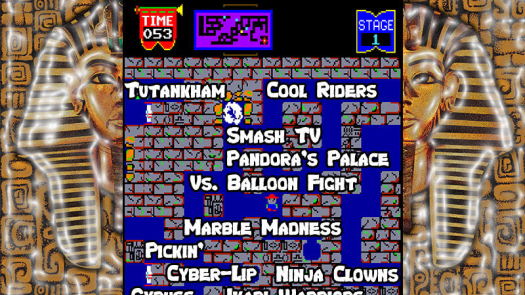2017’s holiday season saw some fairly steep discounts on VR hardware to the point where VR was the big purchase of the season with way more players than ever before. With that perceived increase in players, interest in using the new hardware for competitive gaming has risen. Fortunately, those looking to hone talents in a new arena already have a few options. Even with VR being an infant market, opportunistic organizers have already broken ground on the esports scene with various events.
Where It Begins...

One of the most promising venues for VR esports is the VR Challenger League (VRCL). So far, the League has been covering The Unspoken and Echo Arena on Oculus Rift. The Unspoken is a spell slinging strategy battle between players that relies on accuracy and prediction. It was crafted by Insomniac and has seen some interesting competition in the scene so far. Echo Arena is a more traditional esports title with one huge twist: It’s an anti-gravity sport where two teams challenge for control of a discus to score on the opposing team’s goal. It’s free for all Oculus owners and looks like a combination of Harry Potter’s Quidditch and Tron’s world, complete with melee steals and clever maneuvers to score goals.
We talked to some of players from that tournament, who shared their thoughts on the VR esports scene. Thavex, one of the finalists for The Unspoken, talked about competing at such a high level.
“It was eye opening; I got knocked out first round at the finals,” Thavex recalled. “I found out you really have to be flexible and adjust to the realities of the game at the time. You can't allow yourself to be rigid in your thinking at all and stuck in your ways. Anything you find as a preference can become a comfort and become a limiting factor to winning when you approach esports.”
How To Show It Off

There’s also the factor of presentation. VR is a fairly challenging thing to make look compelling. Lots of waving around in a small space and it just doesn’t have the punch of being able to see the emotions on the player’s face with that headset attached. It’s harder to read the personal narratives, rivalries, and victories. I’m not sure how this could be improved, but presentation should definitely be a part of the equation moving forward.
Thavex did say that the organization of the VRCL was a bit rough around the edges, but was a step above the organization of previous tournaments he had attended. There’s also a new way to watch VR esports that he was excited to share. Insomniac has created a few modes to enhance spectating matches of The Unspoken, which is what was utilized for broadcasting purposes during that tournament.
“The 360 degree spectating options for people using Gear VR, Oculus Rift, and HTC Vive has a lot of potential and is something I'd love to see fleshed out. It’s accessible to view over and over as much as re-watching a YouTube video, so you could pull it up months later and show your friends and family and be like ‘You need to see this. This is what competitive VR looks like’.”
As more viewers and players become familiar with the game and more productions are put on, the experience will be better for everyone involved.
“Just a bit of polishing and tweaking and they're onto a winning formula if they work out the bugs,” Thavex said.
Another player from the VR Challenger League, Reukifellth, also saw potential in the way VR games are presented and praised the way it’s done in The Unspoken.
“I think if that becomes standard more games like The Unspoken will become easier to watch and due to that, become more popular.”
The Difference Between VR and Other Arenas

VR games have a unique set of factors that do not play into most of the other games circulating. For starters, VR is a full body ordeal, meaning stamina becomes a factor during matches and in practices.
Vidman321, also a finalist in The Unspoken at a tournament in Oakland, commented on the physicality of playing.
“Throwing fireballs and trash certainly takes effort, but for VR games the most physically intensive would have to be Echo Arena.”
Reukifellth had a little bit more to say about the rigors of competing in VR games like The Unspoken on a live stage and event.
“Competing in The Unspoken almost felt like competing in a sport. Due to the physical activity involved, you're just moving constantly in these matches and after playing so many rounds on stage, you can really start to feel it causing you to make bad decisions.”
The question is where does VR go from here in the competitive scene? What can be learned from the VR Challenger League? Which games have the capacity to make a splash in this niche space of competitors?
First off, availability is certainly a factor when it comes to fostering more players and diverse skills. There’s a reason League of Legends and PLAYERUNKOWN’s Battlegrounds are seeing so much action competitively; they’re fairly easy to get a hold of and play on a wide range of PCs. For games like Call of Duty or even Smite, there is the advantage of having the title on most consoles. It creates a wide variety of leagues dedicated to those systems. Another popular title, Super Smash Bros. Melee has the Nintendo factor and decades of players learning everything they can to maximize their skill. Each of those games are also fairly easy to follow as a viewer or spectator in a crowd.
Really, if VR is going to take off at the esports level, more players need to be involved as a whole. And that may fall upon the VRCL and other leagues to find those enthusiasts and bring them together.
The biggest advantage in the VR Challenger League is the promotion through companies like Intel, Oculus, and ESL. Getting that content in the same spaces as popular competitions, showing it off in a similar fashion, that will all help bolster the league. It’s also focused on a single console, the Rift, which has its own group of players and fans that are more likely to check it out. Starting off catering to that niche should help get people watching and being involved in the online brackets.
However, it may be a situation where there has to be more constant representation from the other consoles. PSVR and the HTC Vive have to get involved. The same challenges apply to those other two units, but Oculus being a part of the promotion for the VR Challenger League shows a vote a confidence in that system.
What Games Can Become VR Arenas?

Clearly, one of the other hurdles is the software from which esports arenas can be made. On consoles there are monumental hits with constant updates or sequels to keep players coming back; there’s often a history it’s built upon. Maybe there’s an opportunity to tap into what’s already established? Either way, at the end of the day, VR needs its League of Legends or Call of Duty to build a league upon.
There’s also the issue of VR still being new. That said, there seems to be a lot of magic happening in VR development. One look around a PAX floor shows just how many developers are eager to make games on those systems. There are a few games on the horizon with an esports potential that had the players we talked to excited.
“I am pretty excited to see games like Onward or Pavlov VR make it into ESL. I picture a lot of players that are playing Counter-Strike: Global Offensive or PUBG to drift over to the new medium and give some good exposure to VR.” said Vidman321
“I think the standard has been set with The Unspoken and Echo Arena. Some games that I could see coming into the VRCL are the first-person shooter Onward and the upcoming racing game Sprint Vector,” answered Reukifellth.
Despite these optimistic words, it may still be some time before the competitive VR scene takes hold the way other scenes have. Practicality and availability are still hanging over the horizon for the developers, players, and investors in that arena. It remains to be see if these crucial factors can be nailed down to help VR and its competitive ventures achieve a golden age.







